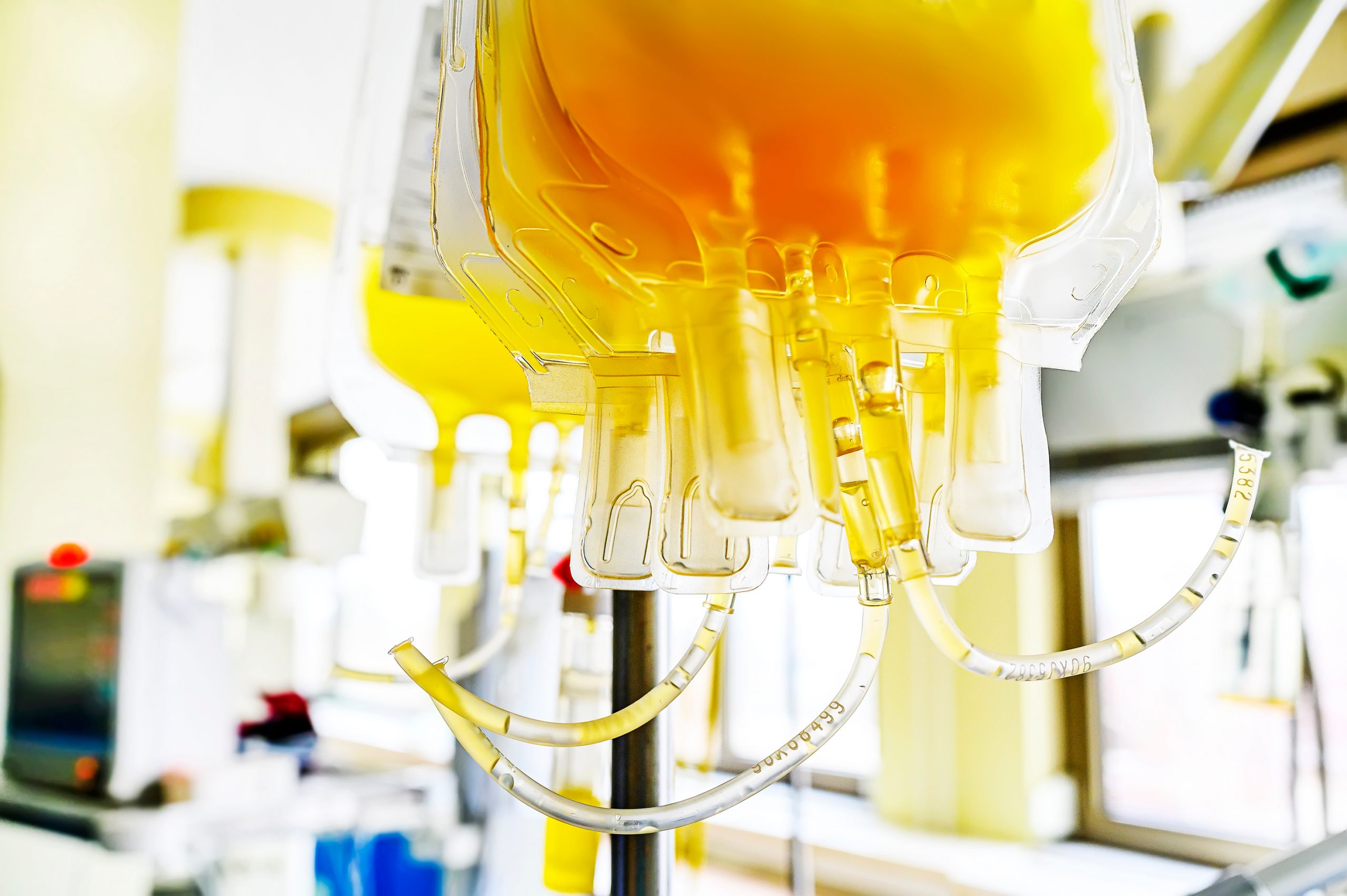Young Plasma Infusions Safe and Potentially Helpful, Small Trial Finds

Infusions with plasma from young adults is safe and well tolerated in people with moderate Parkinson’s disease, and appear to result in rapid and sustained improvements in phonetic fluency and self-esteem, according to findings from a small Phase 1 trial.
These results not only demonstrate the safety and benefits of young plasma infusions for easing disease symptoms, they also suggest that Parkinson’s patients at risk of COVID-19 complications might be candidates for plasma therapy.
The study, “Safety of Plasma Infusions in Parkinson’s Disease,” was published in the journal Movement Disorders.
During the early 20th century pandemic known as the Spanish flu, researchers discovered that plasma from people who recovered from viral diseases contained antibodies that could be used to manage symptoms of that disease in other patients.
This approach — called convalescent plasma therapy — has since been used in many viral diseases with no available treatments, including the coronavirus’ SARS and MERS. Recent reports suggest that it may also be a promising intervention for easing the symptoms of COVID-19.
Plasma doesn’t contain only antibodies against diseases. Many other factors, including salts, organic compounds, water, and more than 1,000 proteins, are also found in this liquid component of blood.
Evidence has suggested that young plasma eased aging mechanisms in rodents, with beneficial effects on cognitive functions, and reduced brain inflammation in animal models of Alzheimer’s disease. The treatment has also been deemed safe and well tolerated in healthy adults and in Alzheimer’s patients, but whether it is safe and effective for as a Parkinson’s treatment remains unknown.
Researchers at Stanford University School of Medicine conducted a Phase 1 clinical trial (NCT02968433) involving 15 Parkinson’s patients with moderate-stage disease and mild cognitive decline. All had been diagnosed at least two years prior to enrollment, and were on stable treatment with dopaminergic medication and/or deep brain stimulation (DBS).
Their average age was 63, and their disease duration was an average of eight years.
Participants received four infusions of young plasma (about 250 ml), given twice a week for four weeks. Young plasma used in this study was donated by men ages 18 to 25.
Throughout the study, patients were required to attend 14 research visits: two screening visits before treatment (one during on and one during off therapy periods), the eight infusion visits, two neurological visits immediately after the last infusion (again, during on and off periods), and two neurological visits one month later, also during on and off periods.
Of note, “on periods” are intervals in which disease symptoms are adequately controlled, whereas “off periods” are those in which the medication wears off before the next dose can be taken, and symptoms start to re-emerge. For patients on DBS, off therapy assessments were done at least 15 minutes after turning off the device.
The trial’s main goal was to establish the safety, feasibility, and tolerability of young plasma infusions in these patients. Exploratory outcomes included changes in motor function, cognition, mood, quality of life, and markers of inflammation in circulation.
Results showed that the infusions were safe and well tolerated, with no serious adverse events reported. Several side effects were noted, with the most frequent being transient skin reactions, involuntary movements, and symptoms of the musculoskeletal and central nervous system. Lab exams, as well as kidney and liver function tests, were not affected by the infusions.
Among 53 minor adverse events, only one quarter (26.4%) were deemed probably related to treatment. All 15 patients adhered to 100% of study protocol.
Preliminary signs of efficacy were seen, with patients showing significant improvements in both phonemic fluency and in stigma (or self-perceived negative attributes) immediately after stopping the treatment, and maintained one month later.
“There was no control group in this [Phase 1] study, but the baseline phonemic fluency scores in this cohort were similar to those from a different cohort of 36 patients with PD [Parkinson’s disease] (of similar age and education) whose phonemic fluency scores were significantly lower than 52 age-matched controls,” the researchers wrote.
Significant immediate and sustained improvements were also evident in unblinded motor function scores — assessed with the Unified Parkinson’s Disease Rating Scale Part III — but these were not kept with blinded data, researchers noted.
However the trend was toward improvement, “with a 2.04 decrease in median blinded UPDRS III (excluding rigidity) scores at the 4‐week postinfusion visit,” the researchers wrote.
Blinded UPDRS III scores were given by a certified rater with access to shuffled video records of patients.
Participants did not experience any plasma-related therapy complications, or freezing-of-gait problems related to the plasma infusions. Among the 12 patients who underwent bradykinesia assessments, no significant changes were observed.
All eight patients with elevated levels of the inflammatory protein TNF alpha before starting plasma therapy showed a drop in this factor after the four weeks of treatment. Six of these people reported skin reactions, as did one patient with normal TNF alpha levels.
“It is unclear whether the elevated TNF‐α [alpha] status directly contributed to skin reactivity, but it was interesting that only 1 of 7 patients with normal baseline TNF‐α had a skin reaction,” the researchers wrote.
This study is believed to be the first demonstrating that young plasma infusions in people with clinically established Parkinson’s disease is safe, feasible, and well tolerated, with no serious adverse events, and with potential therapeutic effects, the researchers wrote.
These findings warrant further investigation into the anti-inflammatory mechanisms of plasma in larger clinical trials, and support the cautious use of plasma therapy for Parkinson’s patients with severe manifestations of COVID-19, they added.






